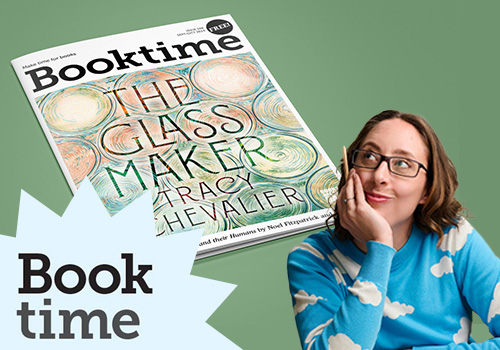Booktime: Interview with Emilia Hart, author of The Sirens
From the author of Weyward, The Sirens follows Lucy as she searches for her sister in a small Australian town with a mysterious past. Weaving together Irish history and traditional tales of mermaids, it is a mesmerising and immersive story. We interviewed Emilia Hart to discover more.
This exclusive feature is from the Jan-Feb 2025 issue of Booktime magazine, the essential guide to the most anticipated books of the season. Find a free copy of Booktime in your local independent bookshop.

"For as long as I can remember, I have loved mermaids. Growing up in Australia, I've always been a water baby, and so of all the mythical creatures, the mermaid resonated the most."
The Sirens is your second novel, following the success of Weyward. Did you find it easier or more difficult to write it?
It was much more difficult to write The Sirens. In fact, I wrote three completely different versions of it before I began the draft that became the published novel! Second book syndrome is very real. I really struggled with the question of how to guide the reader through this dark period of Australian history. The book finally clicked when I realised that for me – as in Weyward – magic realism was the way to light the reader's path.
The book is mainly set in Australia, where you are from. Did you draw on your own experiences to write it?
Yes, particularly in terms of setting. Comber Bay is actually based on a real location on the South Coast of New South Wales – Bateman's Bay, where my aunt and uncle live. I have really fond memories of childhood holidays spent there, and it was a joy to transport myself back to the beaches and cliffs once again.
At the beginning of the novel some pictures of Lucy are leaked onto the internet. Do you think this is an growing problem which young women face?
I do, unfortunately. I think the internet, social media and mobile phones have been really damaging for young people. I'm particularly concerned by men and boys' increasing use of pornography and how this encourages them to see women and girls as objects. In some ways I feel grateful not to be a teenage girl in today's world. On the other hand, I do think that young women now are much better versed in consent and boundaries than my generation were. They inspire me.
The mythical mermaid is at the centre of the novel. What drew you to write about this particular legendary being?
For as long as I can remember, I have loved mermaids. In fact the first film I can remember watching is The Little Mermaid! Growing up in Australia, I've always been a water baby, and so of all the mythical creatures, the mermaid resonated the most. Because I was writing about Irish convicts, I took inspiration from the ‘merrow’ – the Irish folkloric answer to the mermaid. Traditionally, the merrow falls in love with a fisherman and is torn between the land and the sea. This to me seemed symbolic of the dilemma that modern women face – the choice between remaining in the patriarchal world and the struggle and freedom of a life outside these social structures.
The narrative alternates between Lucy in the 21st century and Mary in the 19th century. Did you do a lot of research into the history for Mary’s sections?
Yes – I did a lot of research into convict transportation and Irish history and folklore. In terms of the former, the key resource for me was The Fatal Shore by Robert Hughes, which explores the convict experience in vivid, painstaking detail. I was also fortunate to visit the Hyde Park Barracks in Sydney, a brilliant museum about transportation. In terms of Irish history, I found Modern Ireland by R.F. Foster to be an invaluable resource on Irish modern history, especially in relation to British colonisation. Irish Country Life by Olive Sharkey helped me to gain an insight into Mary and Eliza’s daily existence. I also visited the Museum of Country Life in County Mayo, Ireland, which was absolutely fascinating.
Both Lucy and Mary have a close relationship to their sisters, Jess and Eliza. Do you think that the bond between sisters is a special one?
Yes. I really treasure my relationship with my sister. We've always been close. When I was younger I unfortunately had a stroke, and my sister was such a support during that awful time – I don’t think I would have coped without her. The novel is intended as a tribute to her.
Which other authors inspire you in your work?
There are so many! I’ve always loved Maggie O'Farrell’s writing, as well as Kate Atkinson and Margaret Atwood. Another favourite author is Daphne Du Maurier: her first novel, The Loving Spirit, about a family with a special connection to the sea, was a particular source of inspiration for The Sirens. Other sources of inspiration were Chloe Timms' stunning debut The Seawomen and Julia Armfield's Our Wives Under the Sea. I also love Australian author Tim Winton – the way he writes about landscape is so original and beguiling.
What do independent bookshops mean to you?
For me, independent bookshops are a means of escape from everyday life. You can step into an independent bookshop on a busy high street and moments later find yourself immersed in another world. That's real magic.

About The Sirens by Emilia Hart
Lucy is running from what she’s done – and what someone did to her.
There’s only one person who might understand: her sister Jess. But when Lucy arrives at her sister’s desolate cliff-top house, Jess is gone.
Lucy is now alone, in a strange town steeped in rumour. Stories of men disappearing without a trace. A foundling discovered in a sea-swept cave. And women’s voices murmuring on the waves…
As Lucy searches for her sister, those voices get ever louder. They tell of two sisters, two centuries ago, bound and transported across the world. A world where men always get their way. A world that is at once distant, and achingly familiar.
Are these voices luring Lucy closer to her sister? Or will the secrets of the past pull them both under?
In this extract Lucy goes to Comber Bay, where her sister lives, and where a number of men have mysteriously vanished:
The drive into Comber Bay is tinted green by gum trees that swoop low and close over the road. She winds the window down and breathes in the rich air: the tang of eucalypt, the heady sweetness of wattle. Cicadas hum, and she catches the throaty music of a magpie’s call, the familiar sounds reassuring.
She’s almost forgotten she’s near the coast, until the bush falls away on one side and the bay comes into view, stopping Lucy’s heart in her chest. She checks her rear-view mirror before slowing down to get a better look. It’s breathtaking: a green tangle of scrub, brightened by red flashes of banksia, gives way to the sandstone haunch of the cliff. And then the sea, bright and unreal as a painting. She's never seen so many shades of blue: gleaming turquoise near the breakers; further out, a blue so dark it’s almost black. Lucy shivers, thinking of the world beneath the spangled waves.
The coastline curves around, so that she can see the cliffs on the other side of the bay, honeycombed with caves. Devil’s Lookout. It’s the same view she’s seen already, on Jess’s postcard, but the photographer hadn’t quite captured the eeriness of the cliff face. In person, the caves look deeper and darker; one in particular, closest to the waterline, is large enough that she can almost imagine a demon lurking there, surveying the sea below.
A prickle starts at the base of Lucy's spine. Maybe it’s the knowledge of what the water would do to her skin. She imagines the waves lapping at her like tongues, stripping her flesh until she is nothing but bone, gleaming white.
Or perhaps it’s the podcast; the thought of all those missing men, presumed drowned. But with the prickling fear there’s a strange pull, too. Lucy struggles to tear her gaze from the bright waves, mesmerised by the way they curl over the shore. A part of her wants to get closer, to feel spindrift on her face; slick rock beneath her palms.
It must be the tiredness, she decides, suddenly giddy. She needs to stop driving, to rest. She checks her phone again: still nothing from Jess. Well. Her sister won’t be able to ignore her for much longer.
The main road overlooks the beach, a boundary between bushland and sea. A car park faces the water, a few sedans with surfboards or fishing rods strapped to their roofs. She’s surprised it isn’t busier; the sky is so bright, a burnished blue dome. But then it’s the school term, and a weekday.
Opposite the car park is a strip of shops with faded awnings – a general store advertising everything from the Sydney Morning Herald to fishing tackle, a post office. There's an ice cream parlour and a fish and chip shop, both empty. A café, too, its windows dark, a few chairs and tables jumbled outside.
Strange that somewhere so notorious can look so normal. And it seems an odd place for Jess to live – it’s even smaller than their home town, Dawes Plain, and her sister has always seemed such a city person, talking of Sydney pubs, the latest exhibition she'd seen at the Museum of Contemporary Art or the National Gallery. Things Lucy and her parents had never experienced and couldn’t understand. She seemed to make a point of wearing the city like a cloak, preventing them from getting too close.
And yet, Lucy can see the town's allure. There’s a beauty to it all – the tangled bush, the rolling waves, the endless sky. Like the place wants to swallow you whole, and you want to let it.
Lucy slows down again after she passes the shops, scanning the rest of the town – a couple of homes, a neat redbrick church – for the turnoff to Malua Street. She’s past the beach now, the road taking her through the dark canopy of trees. And then, on the left-hand side, a sign – if it can be called that. The letters etched into the red plank of gum give it a distinctly unofficial feel. The road, too, feels unofficial: more of a dirt track really. Lucy tightens her jaw as the car shudders over the rocks, branches of overhanging trees scratching at the windscreen.
She passes a house near the turnoff and the road banks to the left. Lucy squints ahead, seeing the intermittent flash of blue through the gums. The track grows steep, the Honda struggling up the incline, and Lucy catches a whiff of brine through the open window. At last, Cliff House comes into view, flanked by scarred tree trunks.


